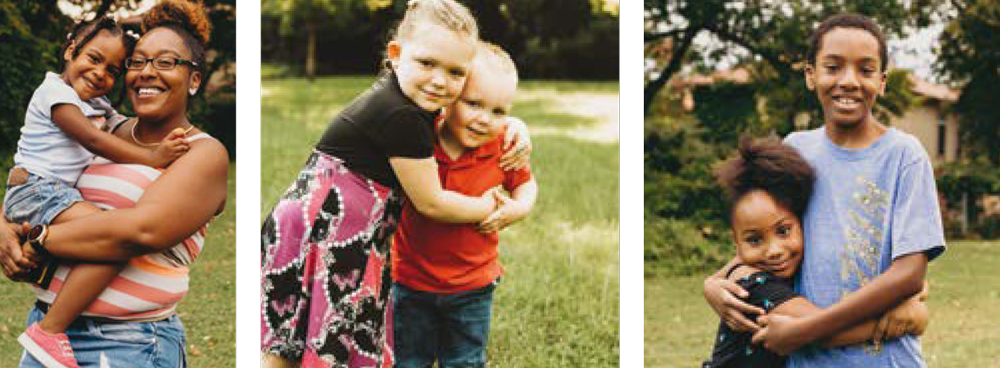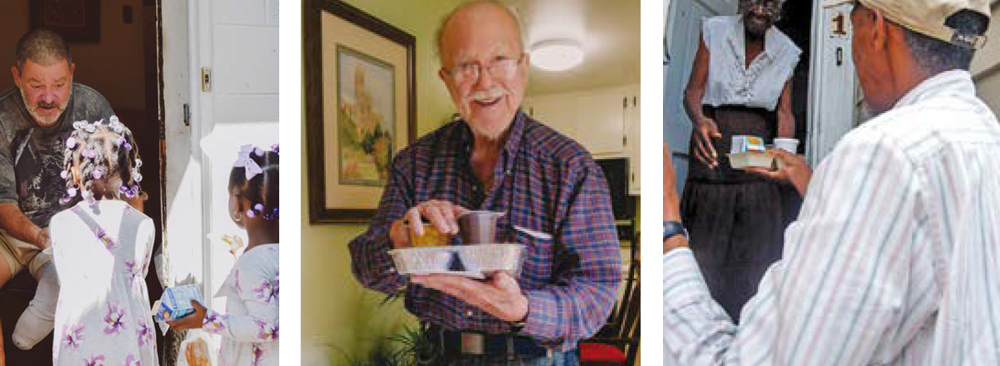Local Non-Profits Welcome Donations, Time and Support

Homelessness. Hunger. These two H words are very different than Happy and Holidays. And although we may be in the season of giving, there are people in our own community all year long who are struggling without the basic needs of food and shelter.
HOME has talked to just some of the local organizations that work hard every day to end homelessness and hunger in our own backyard. If you’re looking for a worthwhile project this winter, or maybe you want to make a resolution to become more involved in the community in the new year, there may be no better gift you can give than a part of yourself.
A PLACE TO CALL HOME
Most of us take for granted a comfy couch to plop down on at the end of the day and a soft bed to sleep in every night. Our only worries are whether our furniture is out of date or it’s time to launder the duvet.
But for the over 800 men, women and children who are homeless in the Lynchburg community every year, there are more important concerns, like having a safe place to live and raise a family.
Miriam’s House
With a mission of “ending homelessness by rebuilding lives and empowering our community’s most vulnerable,” Miriam’s House has provided over 2,500 homeless persons with safe housing and supportive services since 1994. Special emphasis is placed on children, who can experience developmental, emotional and cognitive delays from being homeless. In 2019 alone, 135 homeless children were reconnected with the safety and security of a home.
Miriam’s House has four main initiatives. In the Community First program, families from emergency and domestic violence shelters are assisted in finding stable housing and steady jobs so they can become self-sufficient. A facility on Magnolia Street offers housing to chronically homeless women. The Aftercare Support program ensures families have the resources they need to maintain adequate housing. And more recently, the organization is seeing positive results through its new street outreach program, HOME (Homeless Outreach & Mobile Engagement), where staff members locate persons who are living under bridges, in cars or in parks, and build a connection with them right away so they can assess their barriers to housing and get them immediate help.
On top of this work, Miriam’s House is a hub for all area agencies serving the homeless. “Every community has a lead agency on homelessness that reports to the state, so Miriam’s is that for our community,” says Sarah Quarantotto, executive director. “We collect data for a shared database that all homeless response organizations use. We do trainings on the best way to serve others, hold meetings, and keep a binding list of every person who is homeless in our community. We have regular calls with our partners and have created a system where we don’t want to have any gaps [in services] and we’re all sharing info and everyone gets served.”
Volunteers deliver supplies to families. The biggest needs currently are cleaning supplies, paper products, hand sanitizer and hand soap. Financial contributions (you can join a monthly giving group) often help families with initial rental and utility costs. For more information, call 434-847-1101 or email info@ miriamshouseprogram.org.
 YWCA’s Town Center Women’s Residential Housing Program
YWCA’s Town Center Women’s Residential Housing Program
Another longtime community partner in ending homelessness is the YWCA. Up to 35 women are being served through the Town Center Women’s Residential Housing Program.
“The women are granted the gift of safety and space,” says Ashley Reynolds Marshall, chief executive officer. “With that security of having affordable housing, many of our residents work diligently to increase their income and savings—and then, inevitably, are able to move out of our program into traditional mainstream housing.”
 Marshall says community support of the program has been astounding. “The single biggest way that our community can love their neighbor is through understanding,” she says. “We are so fortunate to work in a community that is filled to the brim with compassionate people who are willing to reach out and help those in need—whether that is due to escaping the trauma of domestic or sexual violence (the YWCA also operates two of these shelters), or whether they are low-income women seeking safe and affordable housing. That compassion has led our community to do everything from donating needed items to our programs, such as laundry detergent, gift cards and hygiene products, to volunteering with our non-profit and others in our community, to providing a donation, large or small.” For more information, visit ywcacva.org.
Marshall says community support of the program has been astounding. “The single biggest way that our community can love their neighbor is through understanding,” she says. “We are so fortunate to work in a community that is filled to the brim with compassionate people who are willing to reach out and help those in need—whether that is due to escaping the trauma of domestic or sexual violence (the YWCA also operates two of these shelters), or whether they are low-income women seeking safe and affordable housing. That compassion has led our community to do everything from donating needed items to our programs, such as laundry detergent, gift cards and hygiene products, to volunteering with our non-profit and others in our community, to providing a donation, large or small.” For more information, visit ywcacva.org.
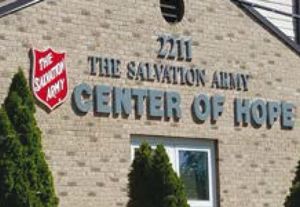 Salvation Army
Salvation Army
When you hear a bell and see a red kettle, you know the Christmas season is in full swing. The Salvation Army has been relying on community support in Lynchburg for 115 years, making it the oldest organization in the city to serve the less fortunate. Currently, it operates the Center of Hope, an 80-bed facility that is the largest homeless shelter in Lynchburg; the Community Feeding Program, where shelter residents and others in need can receive two meals a day; and a social services program, where families receive help with food, utility and rent expenses, clothing, and other necessities.
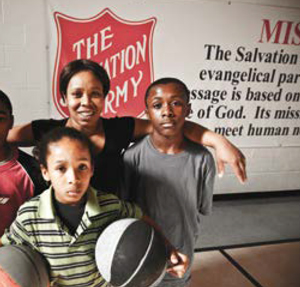 People are truly finding hope at the center, says Tammy Shank, director of development. People like a father on dialysis who lost his home due to mounting medical bills, a local teacher whose child had significant health problems and was also struggling to pay bills, and a young man who was adopted from another country but found himself at the Salvation Army on his 18th birthday because his family situation had become incompatible.
People are truly finding hope at the center, says Tammy Shank, director of development. People like a father on dialysis who lost his home due to mounting medical bills, a local teacher whose child had significant health problems and was also struggling to pay bills, and a young man who was adopted from another country but found himself at the Salvation Army on his 18th birthday because his family situation had become incompatible.
“It’s not always individuals who are sleeping on a bench or living in the park,” Shank says. “And there are misconceptions that homeless people don’t work—that’s not true; we have several who do—they just have a crisis happen to them, like a medical emergency, and they get behind on rent and bills and eventually end up with no place to go.”
The Center of Hope is the only shelter in Lynchburg operating as an emergency shelter, taking walk-ins in addition to those who have been routed through government assistance programs. “The only predetermining factor is that you have a need,” Shank says.
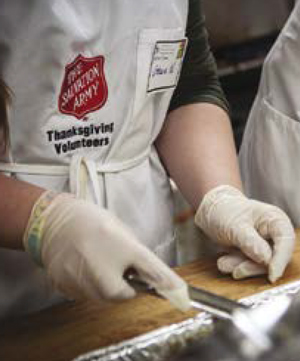 The center is also unique among homeless shelters in that it can accommodate entire families, with suites set up for parents and children. The shelter also has a men’s floor and a floor for women and children. Residents receive a breakfast and dinner every day, yearround, at no cost.
The center is also unique among homeless shelters in that it can accommodate entire families, with suites set up for parents and children. The shelter also has a men’s floor and a floor for women and children. Residents receive a breakfast and dinner every day, yearround, at no cost.
Most people stay at the shelter an average of 30 to 90 days. They commit to following a program that will help them secure housing and transition out of the center.
“Initially, the need might be an emergency, but we want to help get them on their journey and get stabilized. If they don’t have a job, we help them secure a job, and we collaborate with other organizations to help them find a place to stay. We help them learn how to budget their money and learn life skills,” says Shank.
Volunteers work in the kitchen, assist with a clothing closet, and find ways to use their own skills to benefit the shelter, such as landscaping, or teaching community classes on financial literacy or health and wellness.
“At the Salvation Army, we’re also a ministry,” Shank says. “The whole reason why this organization does these programs is that we know the best way to serve God is to serve others.”
 Donations are always accepted. The Red Kettle Campaign actually makes up 25 percent of the organization’s budget, so community support for this program is vital. The campaign also has a virtual option this year, with an interactive platform where you can encourage others to help you reach your goal. To join the campaign and to learn more about volunteer opportunities, visit virginiasalvationarmy.org/ lynchburgva.
Donations are always accepted. The Red Kettle Campaign actually makes up 25 percent of the organization’s budget, so community support for this program is vital. The campaign also has a virtual option this year, with an interactive platform where you can encourage others to help you reach your goal. To join the campaign and to learn more about volunteer opportunities, visit virginiasalvationarmy.org/ lynchburgva.
PROPER NOURISHMENT
According to a 2018 study by Feeding America, Central Virginia counties have an 8 to 11 percent food insecurity rate, a term USDA uses to refer to households who don’t have enough food for family members to live an active, healthy lifestyle. These families often experience hunger at certain times because they have to trade off their income for housing, medical, or other needs. In the City of Lynchburg, the study found 13.8 percent living with food insecurity, or about 11,000 people. With the COVID-19 pandemic and rise in unemployment, food insecurity rates have jumped even higher. A number of local organizations are working together to meet the nutritional needs of area families year-round.
Blue Ridge Area Food Bank
Founded in 1981, the Blue Ridge Area Food Bank is the largest organization alleviating hunger in Western and Central Virginia. The Food Bank operates a branch in Lynchburg, distributing food through a network of partners, including over 15 food pantries and soup kitchens. The food comes from three main sources: donations (corporations and community food drives), the federal government, and through purchases. Some is even obtained from local farms.
In fiscal year 2020, the Lynchburg branch provided 5.1 million meals to families. With the effects of the pandemic and a weak economy, the food bank saw the number of people seeking food assistance for the first time quadruple in April.
But, as the food bank’s website states, “If there’s any silver lining in our new normal, it’s the evidence that we live and work in communities where people care about each other and about folks in need.” People can donate (typically, $1 can provide four meals); volunteer at local food pantries and soup kitchens, such as Lynchburg Daily Bread, Lighthouse Community Center, and several church pantries; and advocate by engaging others through social media and even hosting a virtual food drive as a “hunger hero.” Use the Blue Ridge Area Food Bank’s pantry locator atbrafb.org for volunteer opportunities at nearby pantries.
Park View Community Mission
At Park View Community Mission on Memorial Avenue, “community” is an important part of the name, says spokesperson and volunteer Earl Larkins. “We’re not a rescue mission or church; ‘community’ illustrates the kind of cooperation we have with other non-profits, local government, schools, churches, and anyone who can help. With the poverty rate in the 24501 zip code at 42 percent, we have to work together.”
Three of their programs focus on food insecurity. It started with a free Wednesday night meal, which they now call the Park View Café, Larkins says, and out of that came Food for Families, the city’s largest pantry, where produce, meat, dairy, baked goods, and non-perishables are distributed to about 800 households every month. The third food program is the weekend backpack program called Food for Thought. Bags are packed with seven simple, nutritious meals, and distributed every Friday to any students who aren’t sure if they will eat well until they return to school on Monday. (With COVID-19 and remote learning, delivery has shifted to five pick-up sites at the city’s secondary schools, plus a dozen apartment complexes and community centers.)
“But help with food is just the touchpoint,” Larkins says. Like many other organizations, as the staff serve clients, they also become aware of additional needs. Park View offers a Life Skills Institute to help them acquire employable skills as well as a Community Resource Center, where staff can coordinate with other agencies to find answers, assist in emergencies, connect with mentors, and build relationships.
“When someone thinks of a pantry, they usually think of a handout. We go beyond that, and not just to a hand up, but to a handshake,” Larkins says.
Park View has only been an independent non-profit for three years, but the outreach is extensive. They depend on 1,000 volunteer hours each month to operate Food for Families and 300 per month at Food for Thought. Learn more about the organization, including ways to volunteer, at parkviewcommunitymission.org.
Meals On Wheels
Sometimes there are reasons other than poverty for why people may go without a meal. For those who are homebound and face physical or mental challenges that keep them from preparing their own food, receiving a meal at their doorstep is the highlight of their day.
Long before Door Dash became popular, Meals on Wheels was the ultimate food delivery service, serving up hot lunches to a vulnerable population. Last year, Meals on Wheels of Greater Lynchburg celebrated its 45th year and delivered its 2.5 millionth meal. The organization provides balanced, nutritious lunches five days a week (and a supper for those who medically qualify). Routes, running primarily through the city and just into the neighboring counties, last about an hour. Recipients range in age from 24 to 102.
Like other non-profits, service has expanded dramatically since the onset of the COVID-19 pandemic. In January 2019, Meals on Wheels was serving 312 people in Lynchburg, but as of Sept. 1, 2020, they were serving 486. Most of the new recipients requesting assistance received a meal the next day after they called.
“During the pandemic, our program became even more necessary as people were staying home and limiting exposure because of their very serious health concerns,” says Executive Director Kris Shabestar. The rapid response was “only possible because of the incredible volunteers who deliver the meals,” she adds.
But the job description is much more than a delivery driver. Their visit is also a daily safety check, making sure recipients haven’t fallen or are in a health crisis, and they help them make a connection to their community by forming friendships.
“Isolation is a huge health risk, physically and emotionally, especially now,” Shabestar says. “Knowing someone is going to knock on your door every day can help. Volunteers are often the first eyes on our recipients every day, and checking in can give peace of mind to them and to their families.”
Volunteers can sign up individually, with a friend, or with church members or coworkers.
“If the drive is longer than an hour, it’s often because you’ve been talking to some of the most interesting people in town,” Shabestar says. “There are so many fabulous people in our community who have done incredible things and lived fascinating lives and are so kind and sweet. Having an opportunity to know someone you wouldn’t have crossed paths with before is so rewarding—for both of you.”
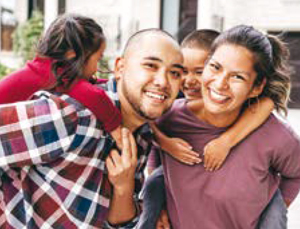 ALL OF THESE ORGANIZATIONS, AND THE MANY MORE WE ARE NOT ABLE TO INCLUDE, HAVE THEIR OWN NAMES, FACILITIES AND STAFF, BUT THEY ALL SHARE COMMON GOALS. THEY ARE COOPERATING TO END HOMELESSNESS AND HUNGER IN OUR COMMUNITY—AND THEIR WORK IS MAKING A DIFFERENCE. AS WE END 2020, PERHAPS THE BIGGEST LIFE LESSONS WE CAN TAKE FROM THIS UNUSUAL YEAR OF “SOCIAL DISTANCING” IS HOW TO COME TOGETHER TO SERVE OTHERS IN NEED.
ALL OF THESE ORGANIZATIONS, AND THE MANY MORE WE ARE NOT ABLE TO INCLUDE, HAVE THEIR OWN NAMES, FACILITIES AND STAFF, BUT THEY ALL SHARE COMMON GOALS. THEY ARE COOPERATING TO END HOMELESSNESS AND HUNGER IN OUR COMMUNITY—AND THEIR WORK IS MAKING A DIFFERENCE. AS WE END 2020, PERHAPS THE BIGGEST LIFE LESSONS WE CAN TAKE FROM THIS UNUSUAL YEAR OF “SOCIAL DISTANCING” IS HOW TO COME TOGETHER TO SERVE OTHERS IN NEED.
There are also “a la carte” volunteer opportunities at certain times of the year, beyond regular routes. The organization does not receive any state or federal funding, so donations are appreciated: $5 will pay for a meal; $110 will provide a month of meals; and $1,300 will provide a year of meals. Visit mealsonwheelslynchburg. org or call (434) 847-0796. ✦
Aftercare Support program, Blue Ridge Area Food Bank, Center of Hope, Community First program, Feeding America, Homeless Outreach & Mobile Engagement, Homelessness, Hunger, Local Non-Profits, Lynchburg community, Magnolia Street, Meals On Wheels, ministry, Miriam’s House, Park View Community Mission, Salvation Army, YWCA’s Town Center Women’s Residential Housing Program
